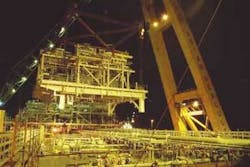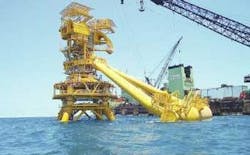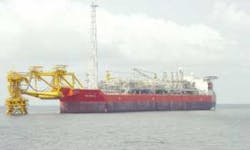WEST AFRICA: EA sees first oil ahead of schedule
Steve Spease
Paul Tan
Keith Warren
Kellogg Brown & Root
Shell Petroleum Development Co. of Nigeria Ltd. (SPDC) and Halliburton's engineering and construction unit Kell-ogg Brown & Root (KBR) achieved a major first on the EA field offshore Nigeria. The group successfully completed the commissioning systems, obtained ready for start-up status, and introduced the first hydro-carbons to the FPSO Sea Eagle on Dec. 14, 2002, one week ahead of schedule.
null
EA is a major SPDC development project. The field is 15 km southwest of the mouth of the Dodo River and 90 km southwest of Warri. Since the field's discovery in 1965, 17 appraisal wells have been drilled in three successive campaigns to delineate the hydrocarbon accumulations. It was not until the late 1990s, however, that the combined impact of improvements in technology and cost optimization made it feasible to economically develop the field.
The development plan for the field includes drilling 55 wells. The first phase of the plan involved constructing three platforms and several subsea pipelines/umbilicals in addition to the FPSO and its associated mooring system, which were carried out by KBR.
Engineering assistance
An EPIC contract was awarded to KBR for the production facilities, including supplying and integrating the FPSO processing systems with the hull facilities to handle 170,000 b/d of liquids. Systems include process modules, the mooring frame, and a flare tower. The contract also encompasses a soft yoke mooring platform (SYMP) comprising a jacket structure and piles, a mooring head and swivel, and a yoke connection to the FPSO.
The contract for the FPSO mooring, topsides integration, and operations support for the EA project is being carried out through KBR's affiliated Nigeria operating unit, Halliburton West Africa Ltd., in association with its affiliate, Halliburton Operations Nigeria Ltd. The contract involves a global execution plan, including engineering, procurement, and construction activities in Nigeria, the UK, Monaco, the US, Korea, Dubai, Abu Dhabi, and Singapore.
Services contracted to KBR include:
- Consolidation/preliminary front-end engineering design (FEED) study
- Overall project and construction management
- FEED and detailed engineering to AFC level
- Procuring all topsides equipment and bulks
- Fabricating the pre-assembled units (PAUs) and flare tower
- Towing the hull from Korea to Singapore (hull free-issued by SPDC, completed by SHI in Korea)
- Integrating pre-assembled units onto the hull
- Onshore pre-commissioning
- Designing and fabricating the SYMP (jacket, mooring head, yoke connection, and mooring support frame)
- Towing the FPSO and SYMP to Nigeria
- Installing the SYMP offshore
- Connecting the FPSO to the SYMP (offshore hook-up)
- Commissioning and start-up (offshore)
- Hand-over of facility to SPDC
- Two years' operations and maintenance support to SPDC.
A definitive FEED and cost study preceded the detailed design. The work was based on the revised reservoir analysis issued in October 1999. The analysis changed the total fluids recoverable per day from 140,000 to 170,000 and increased the gas expected from 65 MMcf/d to 100 MMcf/d.
The consolidation phase resulted in an approved project specification, a confirmed lump sum cost, and firm knowledge of all of the facilities risks expected.
The FPSO
The Sea Eagle FPSO is designed to produce 170,000 b/d gross fluids and 100 MMcf/d of gas. The gas will be delivered to the Nigeria LNG (NLNG) plant at Bonny Island via an offshore gas pipeline being constructed under a separate contract. The Bonny Island NLNG expansion is being carried out by a joint venture group that includes KBR. The Halliburton Energy Services Group is also handling one of the SPDC sub-surface drilling support contracts.
null
The Sea Eagle is a 207,000 dwt vessel with a 274-m length, a 17.8-m draft, and a 50-m beam. The vessel has storage capacity for 1.4 MMbbl and can handle 95,000 b/d of produced water. The FPSO's net oil output is 140,000 b/d.
Management, execution
The project began with engineering and procurement in the KBR Leatherhead office (UK). Major equipment orders were placed for power generators, integrated controls, separators, coolers, a flare package, a pedestal crane, and systems for gas dehydration, chemical injection, gas compression, and produced water. In early October 2000, a successful transition relocated the project to Singapore, where the topsides fabrication subcontract was awarded to Sembawang Marine & Offshore Engineering. The move was facilitated by SMOE's ability to use the KBR PDMS model and similar engineering and project controls systems as KBR's UK and Singapore offices.
null
This allowed the project team to efficiently complete the FEED, detailed design, and procurement work well within schedule. It also allowed direct access to the fabrication and integration yard to ensure that proper constructability was built into the design and that adequate follow-on resources were available throughout the project.
Project interface management
Interface management of the separate contracting scopes for the wellheads, hull, and topsides led to a smooth integration of topsides to the hull. In fact, the procedures and the interface specification developed and implemented by KBR for the EA project have been integrated into a new standard for all future FPSOs at KBR.
null
The procedures and work practices, rev-iewed and accepted by SPDC and the other contracting parties on EA, enabled exchange and control of information and allowed agreements concerning interfaces to be reached in a timely manner.
The Shell and KBR project directors agreed that the smooth transition to Singapore and the interface management process were two of the major successes of the project.
The primary objective for the project was the commitment to health, safety, and the environment (HSE). A project-wide focus was adopted and extended through to all contractors, sub-contractors, and suppliers. HSE inductions, toolbox talks, workshops, and briefings were conducted regularly throughout the course of the project. As a result, the fabrication and onshore integration phase of the project attained 2.4 million man-hours without a lost time incident.
The topside module
Topsides fabrication began in Singapore a week ahead of schedule at the end of Nov-ember 2000. Nine PAUs, totaling approximately 7,000 metric tons of process/utility pallets, were fabricated at SMOE for subsequent integration with the hull in late 2001/early 2002. The PAUs were designed for a maximum lift of 1,100 metric tons using heavy lift vessels available in Singapore.
Semco towed the FPSO, which completed its 60-day voyage to Nigeria on Oct. 3, 2002. The successful management and planning process resulted in the sailaway from the Singapore fabrication yard and arrival offshore Nigeria six weeks ahead of schedule, with all systems, as far as possible, fully commissioned onshore.
SYMP design and fabrication
Single Buoy Moorings designed and fabricated the SYMP under a sub-contract to KBR. The SYMP was designed in Monaco and fabricated in Nigeria, Dubai, and Abu Dhabi.
The SYMP comprises:
- A jacket structure anchored to the seabed via piles
- A mooring head topsides, containing the manifold decks, the main bearing for weathervaning, and the product swivel
- A mooring yoke connecting the rotating head to the FPSO via mooring leg pendulums
- A mooring support structure mounted on the FPSO bow
- A jumper hose arrangement conveying the fluids, electrical power and signals to/ from the FPSO and the drilling platform, pipeline, and umbilical facilities.
The SYMP was completed and loaded out for its tow to Nigeria in early February 2002. SaiBos carried out the towing and installation operation, which was completed in April 2002.
Integration and hook-up
KBR mobilized its offshore and support personnel to Nigeria in September 2002. Early mobilization enabled preparation work with SPDC to be carried out in advance of the arrival of the FPSO. In addition to the project team, vendor support personnel were also mobilized for the offshore hook-up and commissioning work.
The FPSO connection to the SYMP was completed in early December 2002.
KBR and SPDC carried out a detailed audit and review in preparation for the start-up of the facility. The audit covered all aspects of the project, including design, construction, installation, commissioning, and operational readiness.
Having achieved first oil, the KBR and SPDC team are focusing on the final well development and commissioning work required to boost the overall production of the field as additional wells are brought on. The focus in 2003 will be on commissioning the gas compression system to integrate the offshore gas gathering system to the Bonny Island NLNG facility. This work is expected to be completed 1Q or 2Q 2003. KBR is looking forward to the final major milestone, the successful hand-over of the facility to SPDC, marking the end of the EPIC phase of KBR's contract and the beginning of the two-year maintenance and operations support phase.




